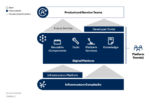
In order to accelerate application delivery and application quality for the digital business economy, BMC today announced Control-M Workbench, a no-cost, self-service and standalone development environment that gives developers autonomy to code, find bugs, and test their workflows.
According to BMC, Control-M Workbench expands on the Control-M Automation API, which enables developers and engineers to embed Jobs-as-Code within the agile application release process. Jobs-as-Code is a practice that requires no scripting to build, test and debug application automation.
The “jobs” in Jobs-as-Code are the automation rules that define how business applications run. These rules include what to run, when to run it, how to determine success or failure, and what action needs to be taken, said Gur Steif, BMC’s president of digital business automation.
In the past, operations analysts defined these rules only at the end of software development lifecycle, said Steif, which meant these jobs were not tested or hardened at the same level as the rest of the application. This approach led to delays and errors, all because of poor communication and manual intervention, Steif explained.
But with the Jobs-as-Code approach, developers can code business application automation directly into their delivery pipeline. And with Control-M Workbench, “operations receives tested, production-ready applications, since jobs are defined at the same time that the rest of the application is built,” said Steif.
Steif added that since the jobs are built in the same general format (JSON), jobs can be stored together with the rest of the application components in a SCM system like Git. It can be built automatically with tools like Jenkins, it can be tested automatically, and then it can be promoted from environment to environment until it eventually is deployed automatically, said Steif.
In addition, the Control-M Workbench environment will work for developers with JSON, REST APIs, and Node.js CLI for creating workflows. Control-M Workbench can also be used to create jobs like Big Data, database, and other enterprise workloads, according to BMC. Developers can build jobs that are immediately consumable by Control-M, said Steif, so operations no longer has to interpret “cryptic documents or diagrams.”
“By making Control-M available to developers without them having to become experts in the installation and configuration of Control-M, Workbench enables developers to access Control-M capabilities during their development process,” said Steif. “Now they can build and test jobs, as well as explore how they can leverage Control-M capabilities.”
Other benefits to Control-M include its ability to shorten the delivery cycle, its self-contained and publicly available to developers, its ability to consolidate tools, and its application quality improvement with “shifting left” job definitions.






